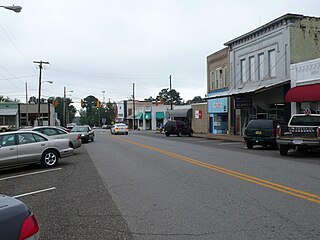
Eutaw is a city in and the county seat of Greene County, Alabama, United States. At the 2020 census, the population was 2,937. The city was named in honor of the Battle of Eutaw Springs, the last engagement of the American Revolutionary War in the Carolinas.

The Mordecai House, built in 1785, is a registered historical landmark and museum in Raleigh, North Carolina that is the centerpiece of Mordecai Historic Park, adjacent to the Historic Oakwood neighborhood. It is the oldest residence in Raleigh on its original foundation. In addition to the house, the Park includes the birthplace and childhood home of President Andrew Johnson, the Ellen Mordecai Garden, the Badger-Iredell Law Office, Allen Kitchen and St. Mark's Chapel, a popular site for weddings. It is located in the Mordecai Place Historic District.
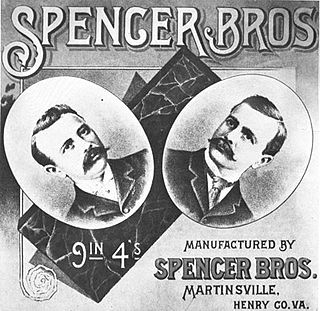
Spencer is an unincorporated community in Henry County, Virginia, United States. It takes its name from its earliest settler, James Spencer Sr., who moved from Loudoun County to Henry County with his sons in the eighteenth century. Spencer's son ensign James Spencer, Jr. died of wounds suffered during the Revolutionary War.
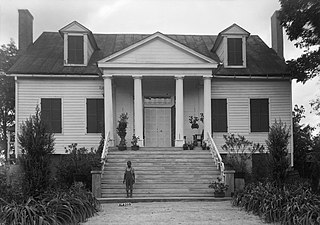
Boligee Hill, now known as Myrtle Hill, is a historic plantation house near Boligee, Alabama. The Boligee Hill plantation was established in 1835 by Dr. John David Means. He had migrated to Alabama from Newberry, South Carolina. Dr. Means had 110 slaves according to the 1850 Greene County census. The house was built in 1840. It was acquired by the Hays family in 1869 and renamed Myrtle Hall for the sweet myrtle growing around it. The property was restored in 2007 by the Beeker family and renamed Myrtle Hill. The house was placed on the National Register of Historic Places on February 19, 1982, due to its architectural significance.

Kirkwood is a historic plantation house in Eutaw, Alabama. The house was recorded by the Historic American Buildings Survey in 1934 and by Carol M. Highsmith in 2010. It was placed on the National Register of Historic Places on May 17, 1976, due to its architectural significance.
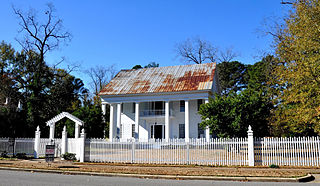
The Dr. Willis Meriwether House, also known as the Clark-Malone House, is a historic vernacular Greek Revival style house in Eutaw, Alabama, United States. The house is a two-story wood-framed building on a brick foundation, six square box columns span the front portico. It was built in 1856 by Dr. Willis Meriwether. The house was recorded by the Historic American Buildings Survey in 1934. It was added to the National Register of Historic Places as a part of the Antebellum Homes in Eutaw Thematic Resource on April 2, 1982, due to its architectural significance.

The William Perkins House, now known as the Freemount, is a historic Greek Revival style house in Eutaw, Alabama, United States. The house is a two-story wood-framed building on a raised brick foundation. Four monumental Ionic columns span the front portico. It was built in 1850 by William Perkins on the Eutaw Town Square. According to the 1850 U. S. Federal Census Slave Schedule, William Perkins' household in Greene County included eleven enslaved people, four women and seven men. Their ages ranged from 2–45 years old, and Mr. Perkins is listed as the slave owner. The house was recorded by the Historic American Buildings Survey in 1934. It was added to the National Register of Historic Places as a part of the Antebellum Homes in Eutaw Thematic Resource on April 2, 1982, due to its architectural significance. It is also listed on the Alabama Register of Landmarks and Heritage.

The Asa White House, also known as the White-McGiffert House, is a historic house in Eutaw, Alabama, United States. It was built in 1838 by Asa White, one of Greene County's earliest settlers. Eutaw was established on property owned by Asa White. He conveyed 20 acres (8.1 ha) to the newly established county seat in 1838 for the building of a courthouse, civic buildings, and a commercial district. He then sold residential lots to individuals. His house is a two-story frame building. It was built in the Federal style and later altered with the addition of Greek Revival-influenced details. The house was recorded by the Historic American Buildings Survey in 1936. It was added to the National Register of Historic Places as a part of the Antebellum Homes in Eutaw Thematic Resource on April 2, 1982, due to its architectural significance.

The Coleman–Banks House, also known as the James Oliver Banks House, is a historic Greek Revival style house in Eutaw, Alabama, United States. It was built in 1847 by George W. Shauver. It was purchased by Rhoda Coleman in 1857 and then by James Oliver Banks in 1890. The house is a two-story structure with four monumental Ionic columns spanning the front portico. It features elaborate Greek Revival doorways in the central bay of the front facade. The house was recorded by the Historic American Buildings Survey in 1934. The Greene County Historical Society purchased the house in 1968. It was added to the National Register of Historic Places on December 18, 1970, due to its architectural significance.

The Catlin Wilson House, also known as the Murphy Dunlap House, is a historic Greek Revival style house in Eutaw, Alabama, United States. The one-story wood-framed building was built in 1844. A pedimented front portico with four Doric columns covers the three central bays of the front facade. The house was recorded by the Historic American Buildings Survey in 1936. It was listed on the Alabama Register of Landmarks and Heritage on November 5, 1976. It was subsequently added to the National Register of Historic Places as a part of the Antebellum Homes in Eutaw Thematic Resource on April 2, 1982, due to its architectural significance.

Borden Oaks is a plantation house and historic district near Greensboro, Alabama, United States. It was added to the National Register of Historic Places on July 7, 1994, as a part of the Plantation Houses of the Alabama Canebrake and Their Associated Outbuildings Multiple Property Submission.

Everhope, known throughout most of its history as the Captain Nathan Carpenter House and more recently as Twin Oaks Plantation, is a historic plantation house near Eutaw, Alabama. Completed in 1853 for Nathan Mullin Carpenter, it is listed on the National Register of Historic Places and Alabama Register of Landmarks and Heritage due to its architectural and historical significance.

The Attoway R. Davis Home, also known as the Attoway Davis Cottage, is a historic house in Eutaw, Alabama, United States. The main block is a two-story I-house, built in 1817. It is the oldest surviving house in Eutaw. Directly in front of this main block is a two-room cottage, built in 1840. The rear of the cottage was later connected directly to the front of the main block. A physician built a one-room office on the grounds in 1850; it was later attached to the side of the two-room cottage. The house was placed on the National Register of Historic Places as part of the Antebellum Homes in Eutaw Thematic Resource on April 2, 1982, due to its architectural significance. It was restored by Ralph and Diana Liverman and now serves as a bed and breakfast.
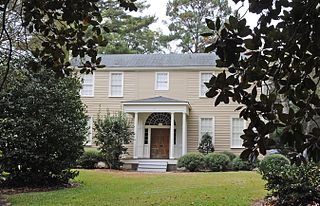
The Rev. John H. Gray House is a historic house in Eutaw, Alabama. The two-story frame I-house was built by John H. Gray in the 1830s. Gray served as the first minister for the First Presbyterian Church from 1826 until 1836. The house was placed on the National Register of Historic Places as part of the Antebellum Homes in Eutaw Thematic Resource on April 2, 1982, due to its architectural significance.
Coleman House may refer to:
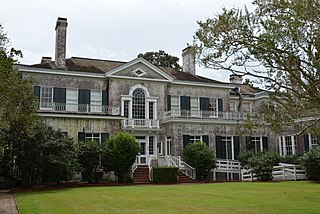
Pebble Hill Plantation is a plantation and museum located near Thomasville, Georgia. The plantation is listed on the National Register of Historic Places.
The Wyolah Plantation is a historic Southern plantation in Church Hill, Jefferson County, Mississippi. It is located off the Mississippi Highway 553.



















